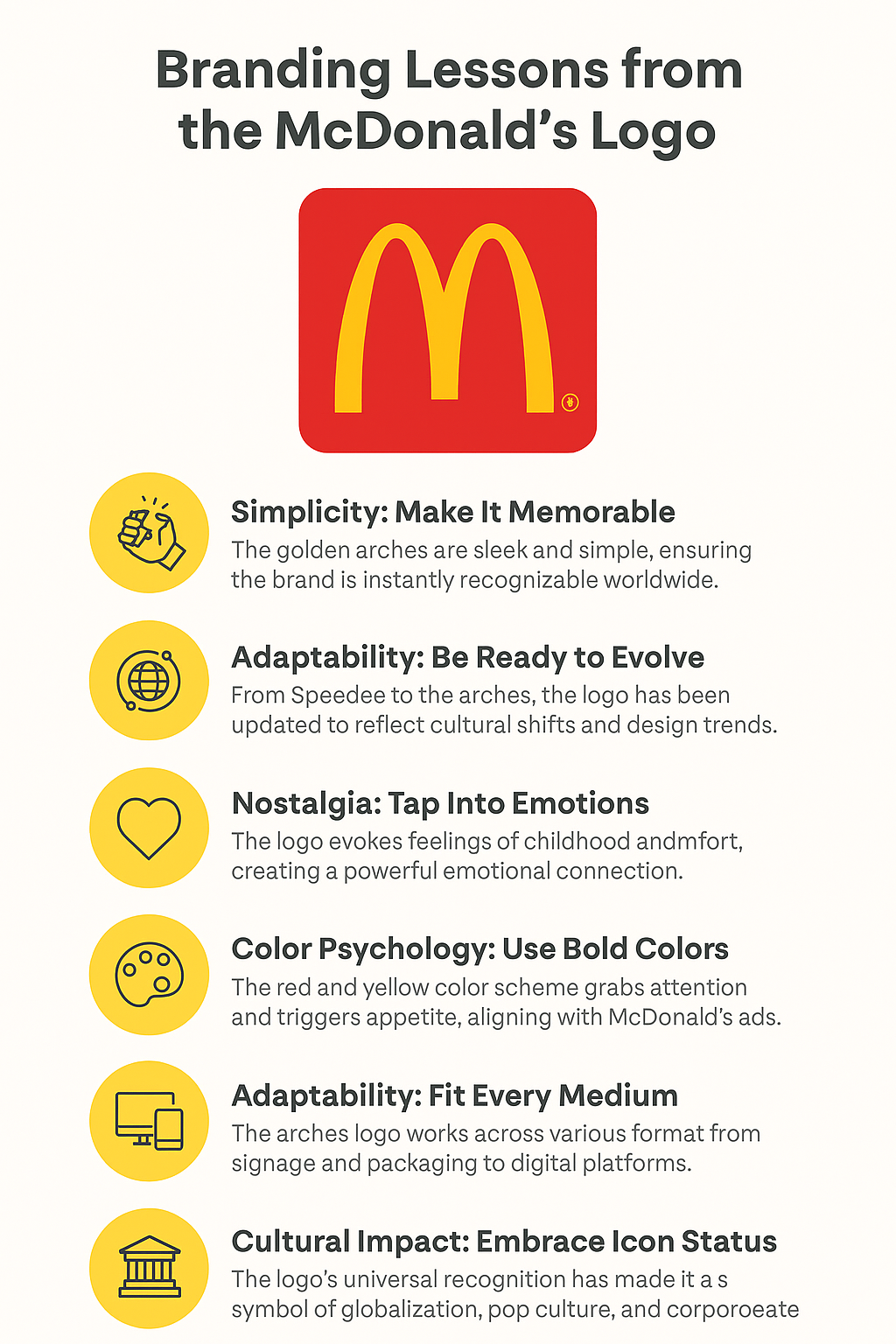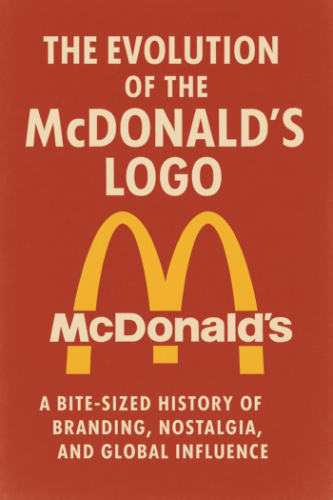A Bite-Sized History of Branding, Nostalgia, and Global Influence
Picture the McDonald’s Logo: More Than a Sign, It’s a Global Symbol
You’re on a road trip, cruising down a highway somewhere between nowhere and everywhere. The sun’s setting, your stomach’s growling, and then—there they are. Twin golden arches glowing like a beacon against the twilight sky. You don’t even need to read the sign. You know it’s McDonald’s. The McDonald’s logo is more than a corporate symbol; it’s a universal language, a promise of fries and a familiar comfort zone in a world that’s always changing.
But how did this symbol become so ingrained in our collective psyche? Let’s take a joyride through the decades to unpack the story behind McDonald’s ever-evolving logo—a tale of marketing genius, cultural shifts, and a sprinkle of french fry magic.
Chapter 1: The Humble Beginnings – Speedee the Chef and the Birth of Fast Food (1940–1961)
Our story starts not with golden arches, but with a cartoon chef named Speedee—a cheery, winking figure in a tall chef’s hat, clutching a burger like it’s the Holy Grail of fast food. In 1940, brothers Richard and Maurice McDonald opened their first drive-in restaurant in San Bernardino, California. At the time, the concept of fast food was still a novelty. Drive-ins were all the rage, but they were slow, messy affairs with carhops and endless wait times. The McDonald brothers wanted to flip the script.
They introduced Speedee, their mascot. With his cartoonish grin and burger in hand, Speedee wasn’t just a logo—he was a mission statement. The brothers had streamlined their kitchen into an assembly line, slashing wait times and prices. As a result, Speedee embodied this efficiency. His name screamed speed, and his design—simple, friendly, almost goofy—mirrored the no-frills, family-friendly vibe they were going for.
However, Speedee wasn’t exactly iconic. He resembled a character from a 1940s cereal box, not a future global empire. When Ray Kroc, a milkshake machine salesman with a knack for big dreams, stumbled upon the brothers’ operation in 1954, he saw potential. More importantly, he saw a branding issue. Speedee was charming, but he didn’t scream revolution. Kroc knew that to franchise this idea, they needed something bolder—something architectural.
Chapter 2: The Golden Arches Rise – From Roofs to Recognition (1961–1968)

In 1961, Ray Kroc bought out the McDonald brothers and hired architect Stanley Clark Meston to design a restaurant that would stop traffic—literally. Meston’s vision? Two massive, parabolic yellow arches straddling the building like a gateway to burger heaven. These arches weren’t just decorative; they were structural supports holding up the roof.
Yet Kroc, ever the marketer, saw something more: a logo in the making.
By 1962, those arches evolved into the first iteration of the iconic M. The design merged the two arches into a single, stylized letter, intersecting at the center like a modernist sculpture. Paired with a playful red-and-white “McDonald’s” wordmark, the logo was bold, geometric, and dripping with 1960s optimism. This was the Space Age—futuristic, unapologetically American, and ready to conquer the world.
But why arches? Symbolically, arches have long represented triumph and entryways. In McDonald’s case, they became a gateway to consistency—a promise that whether you were in Chicago or Chattanooga, your Big Mac would taste the same. Furthermore, they were eye-catching. In a booming car culture, McDonald’s needed something drivers could spot fast. The golden arches did the job.
Fun fact: Early 1960s versions of the M weren’t perfectly symmetrical. They leaned slightly, subtly suggesting speed and forward motion.
Chapter 3: Red, Yellow, and the Rise of a Superbrand (1968–1983)
By the late 1960s, McDonald’s was exploding. The company had gone public, franchises were multiplying, and a certain clown named Ronald McDonald was winning kids’ hearts. To support this growth, the logo needed simplification.
In 1968, McDonald’s made a strategic move: they dropped the wordmark, keeping only the golden arches against a vibrant red backdrop. Red and yellow weren’t random choices. Red triggers appetite and urgency, while yellow evokes happiness and friendliness. Combined, they formed a psychological combo built for fast-food dominance.
This period also introduced the McDonald’s storefront look—tile walls, glowing arches, and massive menus. The branding was designed for clarity and speed. Even the arches evolved. By the 1970s, they stood straight and proud, losing their slight tilt. The red background became a solid rectangle, discarding gradients for a cleaner corporate feel.
Let’s not forget Ronald. Introduced in 1963, he wasn’t just a mascot; he was the fun-loving face of the brand. His bright red hair and yellow jumpsuit reflected the logo’s palette, creating a cohesive visual universe. Ronald was beloved by kids, tolerated by parents, and occasionally ridiculed by critics. Nonetheless, his presence helped humanize the arches. By 1983, McDonald’s boasted over 7,500 locations.
Chapter 4: The Modern Makeover – Minimalism, MTV, and the ’80s (1983–2003)
By the ’80s, the McDonald’s logo embraced minimalism. In 1983, the logo ditched the red background, allowing the golden arches to stand solo. The wordmark returned, this time in sleek black lettering.
This design choice signaled maturity. McDonald’s was now a corporate powerhouse facing competitors and critics alike. The minimalist logo suggested sophistication. It said: we’re fun, but we’re also serious.
Meanwhile, the arches adapted to the times. They appeared in neon during disco-themed ads, bounced to hip-hop beats in the ’90s, and even joined forces with pop icons like Michael Jordan. The logo became a shape-shifting chameleon, able to fit any context while retaining its core identity.
In 1996, the wordmark turned red again—softer, rounder, more personal. This was the era of “My McDonald’s,” a campaign aimed at forging emotional connections. The logo evolved with it, presenting a friendlier face.
Chapter 5: Flat Design, Food Wars, and the 21st Century (2003–Present)
The 2000s brought turbulence. The documentary Super Size Me rocked the brand, making McDonald’s a target in the obesity conversation. The company responded by rebranding and expanding its menu to include salads, wraps, and lattes.
In 2003, the logo was updated with 3D effects—gradients and shadows gave the arches a high-tech, modern look. However, by the 2010s, flat design became the trend. In 2016, McDonald’s reverted to a flat logo: solid yellow arches, a darker red wordmark, and a clean font optimized for digital screens.
Perhaps the boldest move was removing the wordmark entirely in many campaigns. The arches alone were enough. They appeared on coffee cups, delivery bags, and limited-edition merch. This signaled brand maturity and universal recognition.
The arches also embraced global versatility. In Europe, they turned green to reflect sustainability. In Asia, they adapted for cultural packaging. Globally, the McDonald’s logo adapted to reflect local cultures and even made symbolic gestures, such as separated arches during the COVID-19 pandemic.
Chapter 6: The McDonald’s Logo as a Cultural Lightning Rod
The McDonald’s logo is more than a corporate symbol—it’s a cultural lightning rod. It’s been used in political art, satirized in media, and debated in academia. To some, it represents opportunity. To others, it symbolizes excess.
Yet the brand leans into these tensions. When criticized for environmental issues, it made eco-friendly changes. When Gen Z demanded authenticity, McDonald’s delivered real-time social media campaigns and nostalgia-driven collabs with artists like Travis Scott and BTS.
The logo has even entered the fashion world. It has appeared on sneakers, designer bags, and high-end streetwear. In doing so, it transformed from fast-food signage to a symbol of global culture.
Chapter 7: The Impact of the Economy and Ozempic on McDonald’s Sales
The economy and factors like the rise of Ozempic and other weight-loss drugs are having a noticeable impact on McDonald’s sales.
On the economic front, inflation and rising food costs have squeezed consumer wallets, leading some lower-income customers to cut back on discretionary spending, including fast food. While McDonald’s has traditionally been seen as an affordable option, even small price increases can deter budget-conscious diners, especially when grocery store prices become more competitive.
More recently, the surge in popularity of weight-loss medications like Ozempic (semaglutide) and Wegovy is introducing a new challenge. These drugs, designed to curb appetite and help users lose weight, are changing eating habits. Early research and analyst reports suggest that people on these medications tend to consume fewer calories and reduce their fast-food visits, posing a potential threat to companies like McDonald’s that rely heavily on high-calorie, indulgent menu items.
While McDonald’s has diversified its offerings—adding salads, wraps, and lower-calorie options—the brand is still synonymous with burgers, fries, and soft drinks. As more Americans turn to weight-loss solutions, the company may need to further innovate its menu and marketing strategies to appeal to a changing consumer base focused on health and wellness without sacrificing its core identity.
Epilogue: Why the McDonald’s Logo Endures
So what keeps the golden arches standing?
Simplicity. Adaptability. Nostalgia.
The logo design is easy to recognize, flexible enough to fit changing tastes, and emotionally resonant. It evokes childhood, comfort, and road-trip memories.
In the future, the arches might glow in the metaverse or become interactive holograms. But their core promise—warm food, fast service, familiar smiles—will remain. Because no matter where you are, when you see that glowing M, you know exactly what to expect.
And sometimes, that kind of consistency is exactly what we need. Through a mall in Seoul, there’s comfort in knowing that wherever you see those glowing golden arches, you’re home—even if just for a burger and fries.
